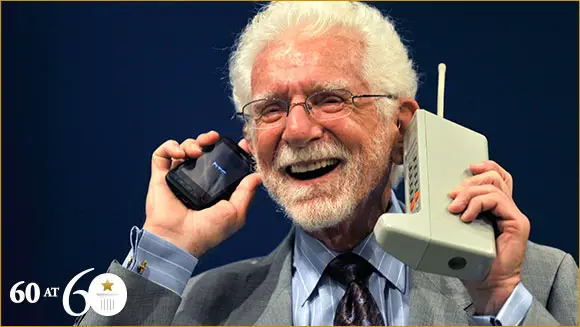
Of all of the technological advancements of the 20th century, arguably the one that has gone on to have the biggest cultural impact has been the invention of the mobile phone.
It caused a shift in the communications industry away from the place towards the person and, more significantly, fundamentally changed the way humans talk to each other.
While there are many players in the story of how cellular telephony came into being, the person who would ultimately go on to make the first historic call on a mobile phone was Martin Cooper.
To use a term from the current vernacular, the call itself, made on the sidewalks of New York on April 3 1973, could also be described as the one of the best examples of an epic troll.
Having gained a Master’s degree from the Illinois Institute of Technology in 1950 Chicago-born electrical engineer Cooper served as a submarine officer during the Korean War, before beginning work with Motorola in 1957.
He soon began to make his mark on the world of communications on the move, helping the firm develop a cellular-like portable handheld radio system for the Chicago police department in 1967.
By the early 1970s, Cooper was heading up Motorola's communications systems division and it was during this period that he conceived his game-changing “personal telephone”, spending the best part of a decade working to bring it to market.
The concept of cellular technology had already been created by Motorola's rival, AT&T, whose Bell Labs introduced a system allowing calls to be moved from one cell to another while remaining on the same channel. However, AT&T was focusing this technology on the car phone, a device that was now becoming commonplace in vehicles across American cities.
Cooper recognised that this was too narrow a vision for on-the-go communications and that the future lay in a fully portable device that offered the freedom of anytime, anywhere telephony.
"People want to talk to other people - not a house, or an office, or a car. Given a choice, people will demand the freedom to communicate wherever they are, unfettered by the infamous copper wire. It is that freedom we sought to vividly demonstrate in 1973," recalled Cooper in a recent interview.
In At&T, Cooper was taking on one of biggest companies in the world, while Motorola at this point were a relatively small company in Chicago. “They considered us to be a flea on an elephant”, Martin explained to the BBC.
Despite the David versus Goliath scenario, Martin’s team began designing a prototype in November 1972, and just five months later they had what appeared to be a near-working prototype.
Costing the equivalent of $1m (£650,000) in today's money to produce and weighing a hefty 2.5 pounds, the 11inch tall, brick-like device called the DynaTAC was ready to be demonstrated to the public.
Motorola called a press conference at the Hilton Midtown Hotel in New York on the afternoon of April 3 1973 to unveil the project. However, prior to the event, Cooper decided to dazzle one particularly sceptical journalist by showing the portable handset in action on the streets of Manhattan.
The reporter watched in astonishment as Cooper dialled the number of his chief competitor Dr. Joel S. Engel, the then head of Bell Labs.
Recounting in a 2011 interview the history making chat, Martin told the BBC: "I said 'Joel, this is Marty. I'm calling you from a cellphone, a real, handheld, portable cellphone.' There was a silence at the other end. I suspect he was grinding his teeth"
Despite the significance of the call, Martin has admitted he never considered how historic it would be: "You never know when you do something like that, that it was the momentous occasion which it turned out to be.
“The issue at the time wasn't about creating a revolution, although that was what happened. It was about stopping At&T."
The DynaTAC made the front cover of the next edition of Popular Science and went on to kick-start a communications revolution. More than 40 years after Martin’s call earned him significant bragging rights, we now live in a world where there are more mobile handsets than there are people.
At 86, Cooper remains involved in the wireless industry and serves as a member of the Federal Communications Commission's Technical Advisory Council.
Smartphones now dominate the world of technology and mark a huge progression from the DynaTAC, but for Martin, they’re not smart enough.
"The future of cellular telephony is to make people's lives better - the most important way, in my view, will be the opportunity to revolutionise healthcare," he told the BBC in 2010.
"The cellphone in the long range is going to be embedded under your skin behind your ear along with a very powerful computer who is in effect your slave".
